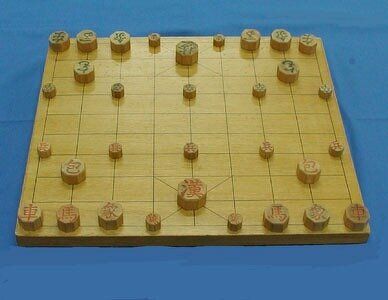Chaturanga (Ancient India)
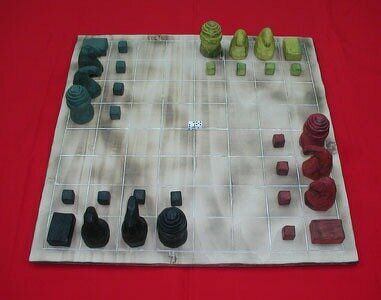
The game is played on a 8x8 squares board. There are 5 different types of pieces and every player has 8 pieces. There is a variant for four players (also known as Chaturaji) and a variant for two players. It is reasonable to think that the variant for two players is the basis of modern chess.
Initially, dice were used. The pieces to be moved were decided by the result of the roll.
The fact that every piece has its unique movement and the fact that pieces can capture enemy pieces if they are on their move path are reasonable evidence to assume that this game later developed into the first ancient chess.
| Name of the piece | Quantity | The movement of the piece and its features |
|---|---|---|
| Rājā (King, placed on the the first rank, on the fourth square from the left corner) | 1 piece | It moves one square in any direction. It has the same movement as the king in shogi. |
| Hastin (Bishop, placed on the first rank, on the third square from left corner) | 1 piece | It moves two squares diagonally. It can jump over other pieces. |
| Aśva (Knight, placed on the first rank, on the second square from left corner) | 1 piece | It moves two squares vertically and then one square horizontally, or two squares horizontally and then one square vertically. It can jump over other pieces. It has the same movement as a knight in chess or a knight (Keima) in shogi that can go in all four directions. |
| Ratha (Rook, placed on the left corner) | 1 piece | It moves any number of squares vertically or horizontally. However, it cannot jump over other pieces. It has the same movement as a rook (Hisha) in shogi. |
| Padāti (Pawn, placed on the second rank, in front of King, Bishop, Knight and Rook) | 4 pieces | It moves one square forward. It has the same move as a pawn (Fu) in shogi |
Makruk (Thailand)
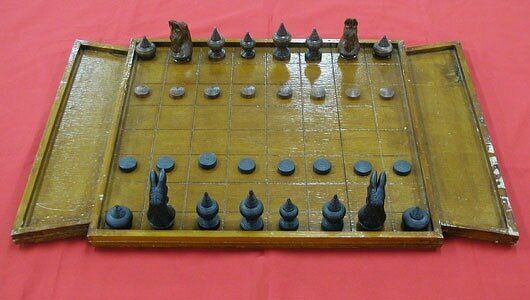
The game is played on a 8x8 squares board. There are 6 different types of pieces and every player has 16 pieces.
Compared to other popular chess variants, it is a game with relatively weak pieces. It is probably quite close to the ancient chess variants.
Its relation with Japanese Shogi is studied because of their similarities: In both games the pawns are placed on the third rank and they can promote when they advance until the 3rd rank of the enemy.
| Meaning of the piece in English and its pronunciation in Thai | Quantity | The movement of the piece and its features |
|---|---|---|
| King (khun), placed in the center of the first rank, on the left of the queen. | 1 piece | It moves one square horizontally, vertically or diagonally. It has the same movement as the King in Shogi. |
| Queen (met), placed in the center of the first rank, on the right of the king. | 1 piece | It moves one square diagonally. |
| Bishop (khon), placed on the first rank, next to the king and the queen. | 2 pieces | It moves one square diagonally, or one square forwards. It has the same movement as the Silver in Shogi. |
| Knight (ma), placed on the first rank, between bishops and rooks. | 2 pieces | It moves two squares vertically and then one square horizontally, or two squares horizontally and then one square vertically. It can jump over other pieces. It has the same movement as a knight in chess or a knight (Keima) in shogi that can go in all four directions. |
| Rook (ruea), placed on the corners. | 2 pieces | It moves any number of squares vertically or horizontally. However, it can not jump over other pieces. It has the same movement as a rook (Hisha) in shogi. |
| Pawn (bia), placed on the third rank | 8 pieces | It moves one square forward. However, when taking a piece, it moves diagonally forward one square. It has the same movement as a pawn in chess. When it advances until the third rank of the enemy, it can promote and move like a queen. The promoted pawn in Thai is called (bia-ngai) |
Chess (International)
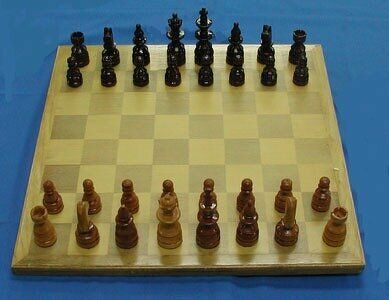
The game is played on a 8x8 squares board. There are 6 different types of pieces and every player has 16 pieces. The main characteristics of the game are the black and white checkered board, special rules such as castling and en passant and the promotion of pawn to any piece other than King when reaching the last rank of the board. It is usually called the king of games. It is said that modern chess was established around the 15th century after several rule revisions.
| Name of the piece | Quantity | The movement of the piece and its features |
|---|---|---|
| King (K, placed on the square with the different color from the piece in the center of the first rank) | 1 piece | It moves one square in any direction. It has the same movement as the king in shogi. |
| Queen (Q, placed on the square with the same color as the piece in the center of the first rank) | 1 piece | It moves any number of squares horizontally, vertically and diagonally. However, it cannot jump over other pieces. It has the movement that combines the movements of rook (Hisha) and bishop (Kaku) in shogi. |
| Bishop (B, placed on first rank, next to King and Queen) | 2 pieces | It moves any number of squares diagonally. However, it cannot jump over other pieces. It has the same movement as a bishop (Kaku) in shogi. |
| Knight (N, placed on the first rank, between Bishops and Rooks) | 2 pieces | It moves two squares vertically and one square horizontally, or two squares horizontally and one square vertically. It can jump over other pieces. It has the same movement as a knight (Keima) in shogi, but it can go in all four directions. |
| Rook (R, placed on the corners) | 2 pieces | It moves any number of squares vertically or horizontally. However, it cannot jump over other pieces. It has the same movement as a rook (Hisha) in shogi. |
| Pawn (P, placed on the second rank) | 8 pieces | It moves one square forward. On its first move it can move two squares forward. However, when taking a piece, it moves diagonally forward one square. |
Xiangqi (China)
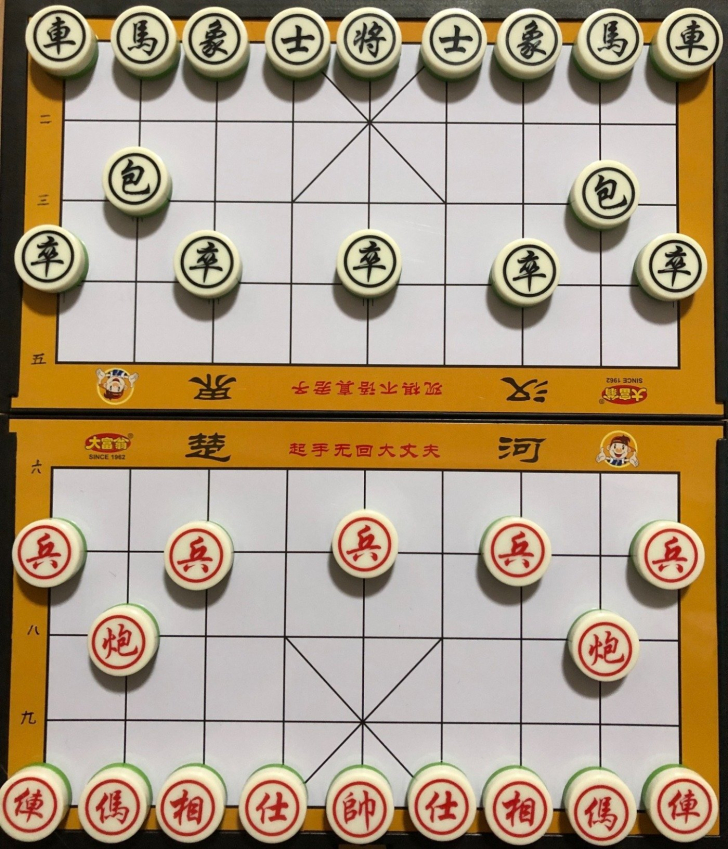
The game is played on a board with 10 horizontal and 9 vertical lines. There are 7 different types of pieces and every player has 16 pieces. The player with the red pieces plays first, then plays the player with the black pieces. Red’s pieces and black’s pieces have different names. Pieces are placed on the intersections of the lines. In the center of the first three ranks for each side there is a palace where points are connected diagonally. Kings and guards can not leave the palace. In the center of the board there is a river, and elephants can’t cross it. The kings can’t directly face each other. In other words, the kings can’t be on the same file without at least one piece between them. Those are the characteristics of the game.
| Meaning of the piece in English and its letter in Chinese (red/black) | Quantity | The movement of the piece and its features |
|---|---|---|
| King (帥/將), placed in the center of the first rank. | 1 piece | It moves one point backwards, forwards, left or right. It can not go out of the palace. |
| Guard (仕/士), placed on the first rank, next to the king. | 2 pieces | It moves one point diagonally. It can not go out of the palace. |
| Elephant (相/象), placed on the first rank, between guards and knights. | 2 pieces | It moves two points diagonally. It can not jump over other pieces and it can not cross the river. |
| Knight (傌/馬), placed on the first rank, between elephants and rooks. | 2 pieces | It moves one point backwards, forwards, left or right and then one point diagonally towards the same direction. Contrary to knights in chess, it can not jump over other pieces. It has the same movement as a knight (Keima) in shogi, but it can go in all four directions. |
| Rook (俥/車), placed on the corners. | 2 pieces | It moves any number of points vertically or horizontally. However, it can not jump over other pieces. It has the same movement as rook (Hisha) in shogi. |
| Cannon (炮/砲 or 包), placed on the third rank, two points in front of the knights. | 2 pieces | It moves like a rook, any number of points vertically or horizontally. However, in order to capture a piece, it must jump over one piece (color of the piece does not matter), and then capture the next piece in the same direction. |
| Pawn (兵/卒), placed on the fourth rank, three points in front of the king, the elephants and the rooks. | 5 pieces | It moves one point forward. After crossing the river, it moves forwards, left or right. |
Janggi (Korea)
The game is played on a board with 10 horizontal and 9 vertical lines. There are 7 different types of pieces and every player has 16 pieces. The player with the red pieces plays first, then plays the player with the blue (or green) pieces. Red’s pieces and blue’s pieces may have different names and are written with different fonts. Pieces are placed on the intersections of the lines. In the center of the first three ranks for each side there is a palace where points are connected diagonally. Like in Xiangqi, kings and guards can not leave the palace. However, in Janggi there is no river on the center of the board and some pieces have different moves. It is also possible to pass, and if both players pass, the game ends in a draw. If the kings are on the same file without at least one piece between them, then the game ends in a draw.
| Meaning of the piece in English and its letter in Chinese (red/blue) | Quantity | The movement of the piece and its features |
|---|---|---|
| King (漢/楚), placed in the center of the second rank. | 1 piece | It moves one point horizontally, vertically or diagonally, following the lines. It can not go out of the palace. |
| Guard (士/士), placed on the first rank, diagonally backwards from the king. | 2 pieces | It moves one point horizontally, vertically or diagonally, following the lines. It can not go out of the palace. |
| Elephant (象/象), placed on the first rank, between guards and knights. | 2 pieces | It moves one point backwards, forwards, left or right and then two points diagonally in the same direction. It can not jump over other pieces. It is possible to swap the initial position of adjacent elephants and knights. |
| Knight (馬 /馬), placed on the first rank, between elephants and rooks. | 2 pieces | It moves one point backwards, forwards, left or right and then one point diagonally towards the same direction. Contrary to knights in chess, it can not jump over other pieces. It has the same movement as a knight (Keima) in shogi, but it can go in all four directions. |
| Rook (車/車), placed on the corners. | 2 pieces | It moves any number of points vertically or horizontally. However, it can not jump over other pieces. Inside the palaces, it can also move diagonally, following the lines. It has the same movement as a rook (Hisha) in shogi. |
| Cannon (包/包), placed on the third rank, two points in front of the knights. | 2 pieces | It must always jump over one piece (color of the piece does not matter) in order to move or capture a piece. Before the jump it moves like a rook, any number of points vertically or horizontally and after the jump it continues to move like a rook in the same direction. It can not jump over other cannons and it can not capture other cannons. Inside the palaces, it can also move diagonally, following the lines. |
| Pawn (兵/卒), placed on the fourth rank, two points in front of the king, and three points in front of the elephants and the rooks. | 5 pieces | It moves one point forwards, left or right. Inside the palace of the enemy, it can also move diagonally forward, following the lines. |
Shatar (Mongolia)
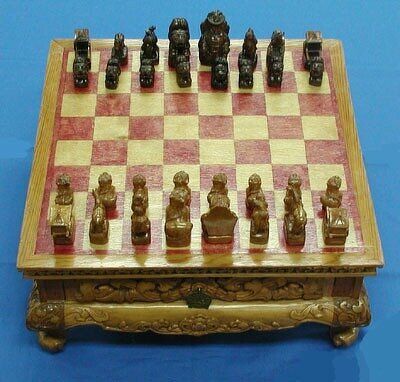
The game is played on a 8x8 squares board. There are 6 different types of pieces and every player has 16 pieces.
It seems that the game had its own rules, but now it is played like chess. Here, we will only introduce the pieces.
| Name of the piece in Mongolian and meaning | Quantity |
|---|---|
| Noyon (lord) King | 1 piece |
| Bers (tiger) Queen | 1 piece |
| Temee (camel) Bishop | 2 pieces |
| Mori (horse) Knight | 2 pieces |
| Tereg (car) Rook | 2 pieces |
| Xüü (kid) Pawn | 8 pieces |


